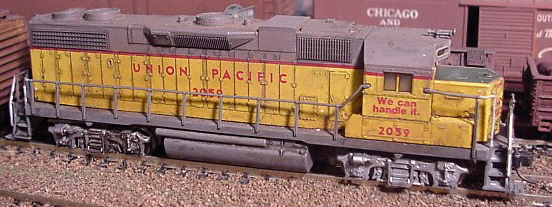

Introduced: 1987, revised 1988
This was the first N scale locomotive produced by Kato's independant American division (as opposed to the models Kato manufactured and exported to the US for Atlas and Con-Cor). Not only did it introduce "blackened" locomotive wheels to N scale, but it also re-introduced flywheels (the 1978 Atlas/Roco FA-1 being the first N scale locomotive so equipped). There were only two manufacturing runs of this model (1987 and 1988), and at this point in history a third run seems unlikely (given the now dated design, along with the fact that both Atlas and Life-Like have released their own GP38-2 models).
The chassis is all-metal and really heavy. The motor is an open-sided 5-poler. The worms are brass assemblies with either two or four flywheels. All wheels are geared and provide pickup (no traction tires). The truck gearing is all plastic. Directional lighting is provided by a metallic PC board screwed to the top of the chassis. Couplers are truck-mounted Rapidos (IE, open pilots). Wheel flanges are low-profile, so no problems running these on Code-55 track.
This is a great looking and great running model of a popular prototype. Pickup is perfect, throttle response is fine, and slow speed creep excellent. Pulling power is off the charts. In fact, legend has it that this might well be the strongest pulling engine ever built in N scale.
On the downside, the mechanism is extremely complex and has a reputation for being somewhat finicky. If any of the interlocking parts get even slightly out of alignment, what you wind up with is a very noisy locomotive (and one that is extremely difficult to tune and otherwise de-noisify). Kato addressed this in their second run by replacing the plastic (rubber?) tubing between the flywheel/driveshaft assemblies and the motor with hard plastic (see below for the rest of the story). Either version has the potential for running smoothly and quietly, but the second release is apparantly less apt to go all "barbershop razor" on you. Second run Geeps are easily identified by the "A" on the bottom of the fuel tank.
In addition to the truck-mounted couplers and open-pilots, these models also originally came with unicolor handrails. However, at this stage of the game it's pretty difficult to find a GP38 so equipped. These days you're more likely to find them with custom painted handrails and steps, and with the truck-mounted couplers and open pilots replaced by a Micro-Trains pilot/coupler assembly (as pictured).
There are other differences between the first and second run Kato GP-38's, and to help explain them all, allow me to turn things over to noted locomotive guru, Ron Bearden:
The Kato GP38-2 was a remarkable locomotive when it was introduced. The number one contribution that it made to N scale was significant usage
of flywheels. The Atlas/Roco FA-1 holds the distinction of being the first mass produced locomotive in N scale to use a flywheel, but that flywheel
was made of aluminum and the effect was minimum. The flywheel effect in the GP38-2 was significant.
The GP38-2 was released in two runs and Kato made significant changes between the runs. In fact, the second run was a re-designed locomotive.
Because this is such an old locomotive, there is much confusion about the differences between these two runs. Hopefully, this rather extensive
description will clear up that confusion.
With the exception of locking tabs on the ends of the shell on the second run (the first run does not have these tabs), the shells are the
same between the two runs.
However the mechanisms are very different.
Assuming you have original parts, aside from the road number of the painted shell, you can tell a first run from a second run by looking at the
fuel tank. The first run has just a Kato part number. But the second run has a letter A added to it.
However, this is not a foolproof identification since fuel tanks can be changed. Externally, the only foolproof identification is to inspect the truck
plates. Do they only come out to the inside of the outer axle (first run)? Or do they go all the way out to the end of the truck (second run)? This
distinction may be subtle to some people. In the photos below, first run is left, second run is right. You can also see the differences in the
flywheels.
But, of course, what do they look like with trucks on?
Here is the chassis with the shell off. Does each truck have one flywheel or two?
Now here is a close-up of the worm area. The left photo is run one, right photo is run two.
In run one, the motor sits loose in the metal frame (left photo). However, in the second run, the motor and drive train are affixed to the walkway
(right photo).
Here is the motor from run one. The flyworms are pressed directly onto the motor shaft.
Run one was susceptible to being noisy. If the flyworms weren�t balanced absolutely perfectly, then they would wobble slightly creating noise.
But not only that, I found there could be a problem with flash which scraped a flywheel (yellow arrow) or with the worm rubbing the frame
(red arrow)-as seen in the photo below.
The second run was better. An end bearing held the flyworm (see blue arrow below) and a �joiner� connected the flyworm to the motor.
As long as everything was straight, this was a pretty quiet mechanism. However, if it ever got out of alignment (like if you ever had to replace
the handrails) then I found it almost impossible to get perfectly quiet again.
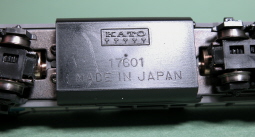
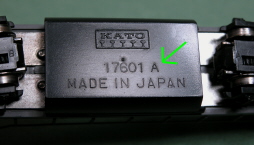
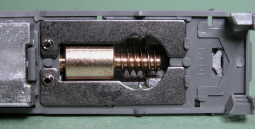
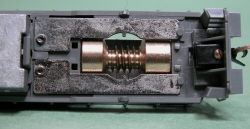
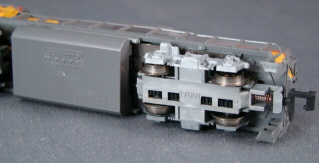
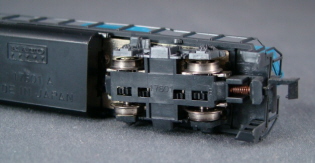
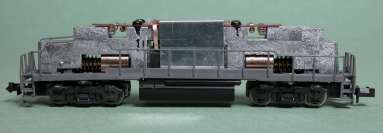
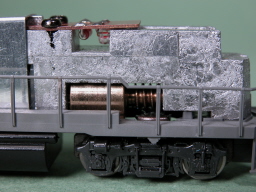
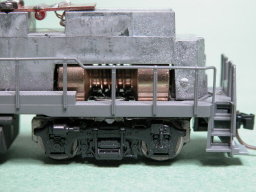
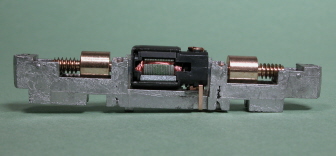
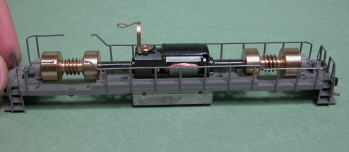
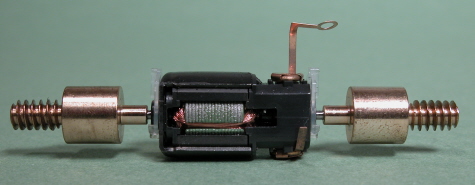
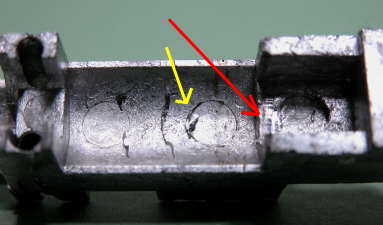
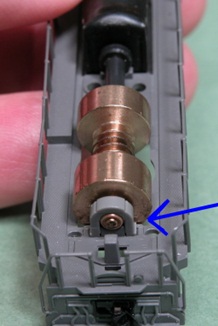
Removing the shell is pretty simple - just unhook the handrails from the cab and then pull up on the shell. It should lift off easily (the battery boxes will come loose, but that's to be expected). The walkway/handrail assembly is firmly fixed to the chassis, so don't expect that to come up with the shell (and don't ask me how to get that thing off, I have no idea).
For complete disassembly instructions, check out Ron Bearden's article in N-Scale Magazine (July/August 1990, Vol 2, Issue 4, p. 35-37). And if you can't find a copy of the actual magazine, it's also available on the N-Scale Magazine. Volume 1 CD-ROM.
Trivia - Back in the late 80's / early 90's, Micro-Trains sold Kato GP38-2's as part of one of their "Tabletop Railroading" sets -
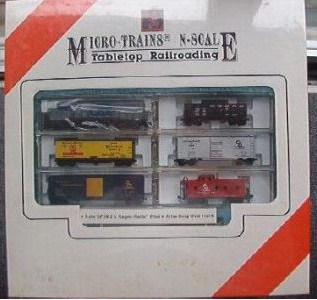
Grade: A
Reviewed: 12/87 Railroad Model Craftsman, 6/87 Model Railroader ("For many years Kato has manufactured high-quality N and HO model locomotives for American companies. Highly regarded examples include Atlas' HO and N scale Alco road switchers and Con-Cor's PA-1, DL-109, U50 and UP turbine. Last year this Japanese firm decided to enter the American market directly and opened an American office. Their first American prototype offered under their own brand name is this N scale GP38-2... I checked the locomotive's dimensions against (our drawings) and found it right on... The body shell is crisply molded and beautifully detailed. The little things add up to quality: the lines around the doors are finely etched and the rivets are scale. The horns are scale and opened up, rather than just being solid across the ends. The filler caps look like filler caps, not just little blobs. The steps and handrails are fine and close to scale. (The handrails measure .016".) Look at the fan housings and you'll actually see the fan blades under the grills. Drop steps and m.u. receptacles are included on the ends... Very nicely painted and lettered. One major problem is that the side sills and handrails are not painted. Keeping paint on the extremely flexible railings would be quite difficult...
"The body pulls off the deck, exposing a cast-metal frame that maximizes the unit's weight. (There's also a metal weight in the fuel tank.) Four long screws through the frame hold the entire works together... The five-pole, double-ended, open-frame motor appears to be basically the same as the motor used in the Atlas RS-3 and RS-11. The drive shafts, flywheels and worm gears are brass and appear to have been made all in one operation, a process that should guarantee a perfectly concentric flywheel... The wheels have a shouldered design that gives them plenty of contact area on the axle and makes wobbling nigh-on impossible. They are chemically darkened, a feature I haven't seen in an N scale locomotive driver before. Flange depth is .023", and the wheels conform to NMRA standards. There are no plastic traction tires... This little engine runs like a dream. The locomotive starts moving smoothly at its minimum speed - no jackrabbit starts here. At low speed you can hardly hear it. The top-end speed is quite high... Do the flywheels work? Obviously in this small size they can't work miracles, but all staff members who watched the locomotive in action believed the could see a difference. The engine would coast further than we expected when turned off at high speed. The flywheels should help in getting the locomotive past dirty spots at low speeds and certainly can't hurt. The competition is tough - those other great locomotives made by Kato - but I'll go out on a pretty sturdy-looking limb and say this is the best-running N scale locomotive yet made. BN, Conrail, CSX, SF, UP. Price: $54.95")